
The historic Ard Godfrey House, built in 1848, is the oldest stick frame home in the Twin Cities. The house, now owned by the Minneapolis Park and Recreation Board, is named after a man who helped build the first dam and sawmills for waterpower at Saint Anthony Falls along the Mississippi River.
The house has undergone several refurbishing projects over the years, including a few structural moves before finding its current home in Chute Square on the corner of University Ave and Central Ave SE in Minneapolis. Recently, Hennepin County helped with replacing sections of damaged exterior siding around the building.
The project provided opportunities for job skills training, relied on unique community partnerships to preserve the home’s historic character, and prioritized the use of salvaged building materials.
Project highlights
|
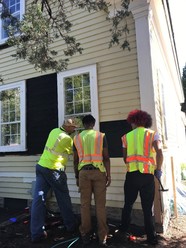 |
|
The siding replacement is being conducted by carpentry apprentices in Hennepin County’s Community Productive Day program, which provides clients with the skills and training to secure meaningful employment. |
The replacement siding is made from old growth Douglas Fir beams from Bauer Brother Salvage – a building material reuse warehouse that has been a staple in north Minneapolis since 1960. Not only will the old growth lumber match the current siding, it’s also a valuable building material because of its natural durability and rot resistance. |
|
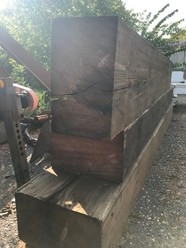 |
 |
|
MPLS MAKE, a member-based community woodshop in Columbia Heights, used their sawmill to transform the old growth beams into usable siding of specific sizes for the Ard Godfrey House. |
The county’s commitment to building material reuse and recycling
This project is part of the county’s effort to increase reuse and recycling of building materials to reduce waste going to landfills.
The county also offers deconstruction grants to property owners to maximize the salvage and recycling of building materials during home remodeling projects. In fact, Hennepin County was recently awarded Deconstructor of the Year at the national Build Reuse Conference for this program
The county also focuses on incorporating reuse and recycling of building materials into county-owned projects.
Interested in incorporating reclaimed wood or other used building materials into your next home improvement project? Find a list of building material reuse organizations and tips for reducing waste at www.hennepin.us/salvage.
In October, the county board approved the county’s 2022 – 2025 Residential Waste Reduction and Recycling Funding Policy (PDF), which guides how the county allocates funding to support city waste reduction and recycling programs.
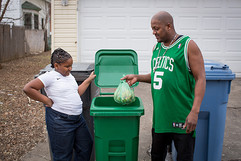
Cities play an important role in the solid waste management system, collecting over 100,000 tons of recyclable materials from 353,000 households in 2020. City programs also collected just over 8,000 tons of organics. The funding policy continues county support for city programs.
The policy prioritizes support for organics recycling programs and focuses on reducing disparities and increasing access by allocating funding to multifamily recycling programs and organics recycling drop-off programs.
|
About the policy
Each year, Hennepin County receives funding from the State of Minnesota’s Select Committee on Recycling and the Environment (SCORE) and passes all of that funding on to cities to support their waste reduction and recycling programs. The Residential Waste Reduction and Recycling Funding Policy guides how that funding is distributed and outlines requirements for cities.
Engagement that informed the development of the policy
To develop the policy, county staff met with city recycling coordinators to gather feedback, address questions and concerns, understand limitations, and gain insights about residents’ experiences with recycling programs. The county also surveyed city communication staff to inform the education requirements.
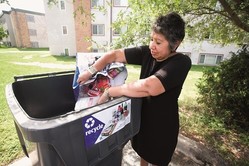
Staff used the county’s Racial Equity Impact Tool (REIT) to ensure changes to the funding policy aligned with county disparity reduction goals. The application of this tool revealed that residents of single-family homes benefit from the funding distribution, while residents of multifamily properties do not benefit as much from the funding or have as much access to services.
The feedback and analysis led to two major changes: more up-front funding to help grow organics recycling programs and more resources allocated to support waste reduction and recycling programs in multifamily settings.
For more information, contact Ben Knudson at ben.knudson@hennepin.us.
|
Hennepin County is proposing to build an anaerobic digestion facility adjacent to the county’s Brooklyn Park Transfer Station. The facility would be a way to turn food scraps and other organic materials, which currently make up about 30% of our trash, into clean energy and compost to grow healthy food.
But what is anaerobic digestion, and how does it work? Watch our new video (YouTube) to learn about the process of anaerobic digestion and the benefits the facility would provide.

How anaerobic digestion works
The video explains how organic waste collected from homes, schools, and businesses would be brought to the facility, shredded, and loaded into a digestion tank. In the tanks, microorganisms would work to break the materials into two products:
The county's vision for an Eco Center
The video also shares the county's vision to establish an Eco Center that provides educational experiences, houses a green jobs learning center, includes an on-site urban farm and greenhouses, and delivers healthy food to our hunger relief partners.
With adequate funding and community support, these strategies would help advance our climate action, zero waste, and healthy community goals.
For more information, contact Ben Knudson at ben.knudson@hennepin.us.
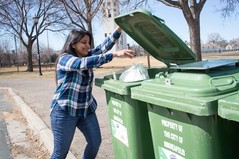
Hennepin County recently awarded $47,200 to three cities to open a total of seven new organics recycling drop-off sites. The drop-off sites funded by these grants will increase access to organics recycling for all residents, especially those living in multifamily properties without access to city service and those in cities that don’t offer service. Drop offs also help raise awareness about the benefits of organics recycling and build interest in additional programs.
About 30% of our trash is food scraps and other organic material, making organics recycling our biggest opportunity to reduce our trash, make progress toward our zero waste goals, and take action on climate change.
|
Organics recycling drop-off sites coming soon
The following organics recycling drop-off sites will open in fall 2021 or early 2022:
- 5 sites in Minneapolis at the following parks: Holmes, Elliot, Towerside, Stewart, and North Commons
- 1 site in Crystal at the Aquatic Center
- 1 site in Minnetrista at City Hall
Education sessions about new drop-off sites in Minneapolis
The City of Minneapolis is opening three new drop-off sites this fall at Holmes Park, Elliot Park, and Towerside Park. They are holding the following education sessions for residents to learn more:
- Monday, November 1 from 6 to 7 p.m.
- Tuesday, November 9 from 6 to 7 p.m.
Existing organics recycling drop-off options
There are currently 28 organics drop-off sites in Hennepin County, including at the county’s drop-off facilities in Bloomington and Brooklyn Park and in several other cities. Learn more about drop-off sites.

Applications are being accepted for the next cohort of Minnesota Water Stewards. Minnesota Water Stewards is a volunteer program designed to equip community members with the knowledge and skills needed to improve water health at the grassroots level.
Stewards participate in an online training course from January to April, and then develop a capstone project that improves the health of local water while involving and educating the community. Hennepin County sponsors and mentors a cohort each year.
Interested participants must attend an information session and submit an application. Information sessions will be held Tuesday, November 9 at 5 p.m. and Tuesday, November 16 at noon.
|
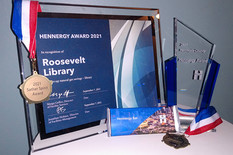
Reducing energy use and increasing energy efficiency in buildings are key strategies to achieving the county’s goal of net zero carbon emissions by 2050. Staff in Facility Services, which maintains and operates nearly 6.5 million square feet of county building space, have been focused on saving energy for decades, and those efforts have had a big impact over time.
In 2019 alone, Hennepin County saved nearly 17 million kilowatt hours of electricity. This is enough energy to charge an electric vehicle 340,000 times and drive it 22 times around the world!
Implementing changes to have the greatest energy savings have been so positive for staff that Facilities Services holds recognition event called the Hennergy Awards every year.
So, what actions give Hennepin County the most bang for the buck in both energy and cost savings?
- Converting to LED lighting
- Installing more efficient equipment and building controls
- Turning off equipment and lighting when not needed
Learn more about how these changes have yielded big savings on the Climate Action website.
|
Stop Food Waste Challenge workshops
-
Kids in the kitchen: Saturday, November 6 from 10 to 11 a.m. Discuss age-appropriate kitchen tasks for kids, ways to help develop healthy eating habits, and learn to cook mini pizzas.
-
Cooking and storage: Tuesday, November 9 from 6 to 7 p.m. Discuss safe handling and storing perishable foods as well as using ingredients in multiple meals and how to be flexible with recipes. Learn to cook a veggie and rice stir fry.
How tracking food waste can be the most important thing you do to reduce it
Here in Hennepin County, we throw away enough edible food each year to fill Target Field 1.5 times! You may be surprised to learn that much of that food waste happens at home.
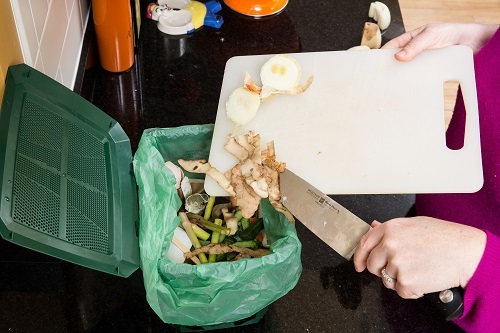
But that’s also good news. We have the power to significantly reduce the amount of food that goes to waste, put more money in our pockets, and have a positive impact on climate change by making changes in our kitchens and when we go shopping.
But where do you get started? Many people working to reduce food waste have found that simply tracking what food goes to waste and why has the greatest impact on preventing food waste in the future. Knowledge is power!
How to track your food waste
Use the food waste tracking worksheet (DOCX) to explore food waste in your household.
Recently, participants in the Stop Food Waste Challenge spent a week tracking their food waste, and found that vegetables, fruit, bread and other baked goods, and leftovers were the most common types of food wasted.
Track the food you throw away for a week or two. To get a complete understanding of food waste in your household, we also recommend assessing what food you have in your fridge, freezer, and pantry that you are unlikely to eat.
|
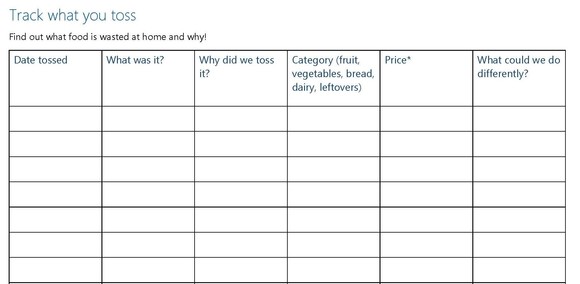
Discover the root cause of wasted food
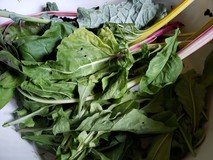
The worksheet not only has you track what you tossed, but also asks you to reflect on why the items went to waste and what you could do differently to avoid wasting it in the future.
Make sure to think carefully about the reason your food went to waste.
For example, it’s probably not just that the food spoiled. Did it spoil because you purchased too much of it? Did it get lost and forgotten in your fridge? Or did you buy some fruit or vegetables for healthy snacks but never found yourself reaching for them?
Losing track of food in the fridge or freezer and not cooking food in time were the most common reasons for food waste for the Stop Food Waste Challenge participants.
The more you dig into the root cause of why the food was wasted, the better you’ll be able to come up with effective solutions.
|
Take action
Stop Food Waste Challenge participants came up with many things they could do differently to prevent food waste in the future, including planning better – especially for using leftover ingredients – keeping their food inventory up to date, better organizing their fridge, and buying or making less food.
Learn ways to reduce food waste and explore resources to help in the following articles on the Climate Action website:
|